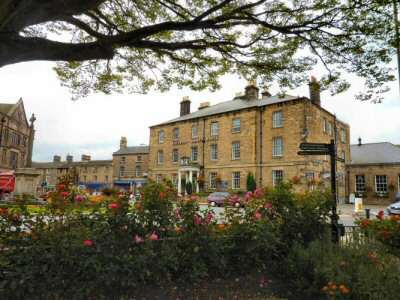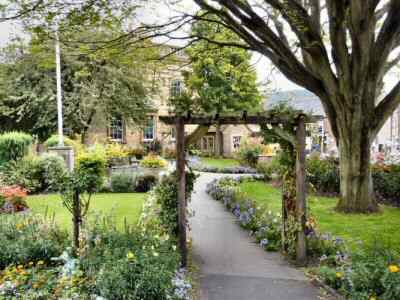BAKEWELL
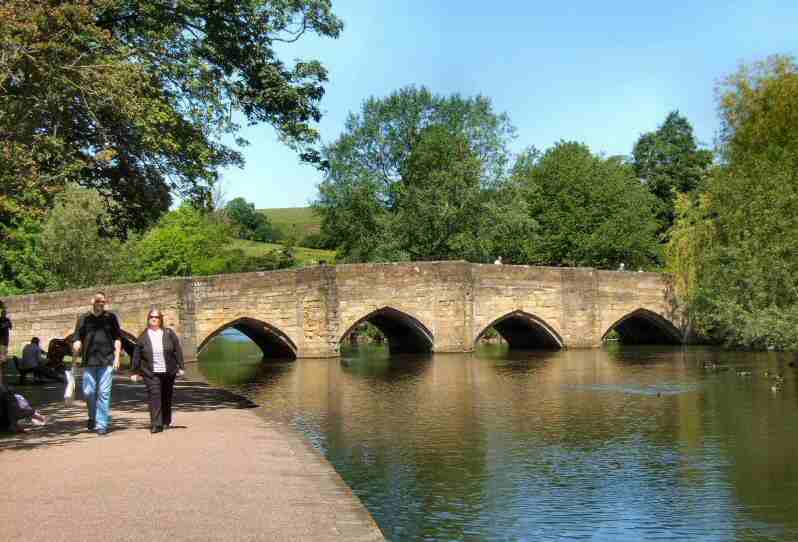
PLAN YOUR DAY OUT
Location: Bakewell is on the A6 between Matlock and Buxton (SK218685).
Visit: Visit the Old House Museum and the Old Market Hall. This impressive building dates back to the 17th century and now accommodates the National Park Visitor Centre and exhibitions. The famous Bakewell open-air market takes place every Monday.
Refreshments: Bakewell Pudding Shop is a great favourite. The town has several pubs, cafes, and restaurants to suit all tastes.
Walk: Edensor and Chatsworth Park Walk—a walk through attractive parkland with stunning views of Chatsworth House and a chance to visit Edensor, one of the country’s most unusual and admired villages.
Special Places of Interest: Chatsworth House, a stunning stately home with beautiful gardens, art collections, and a rich history; Monsal Trail, a scenic walking and cycling route through the Peak District National Park that showcases Victorian engineering and magnificent views; and Haddon Hall, a medieval manor house with exquisite architecture and gardens.
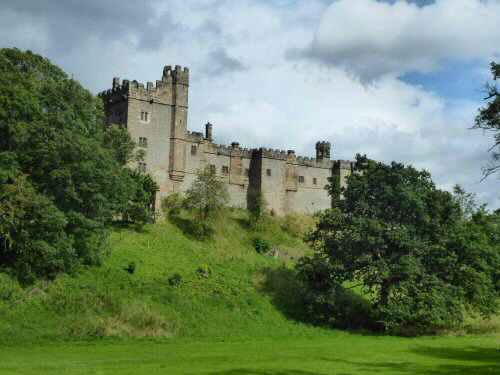
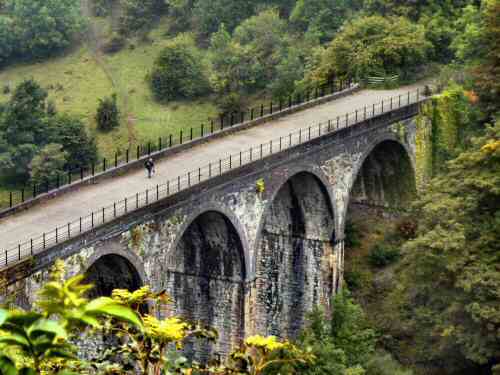
INTRODUCTION
Bakewell is a charming market town in the Derbyshire Dales and the only town within the Peak District National Park. It’s famous for its delightful Bakewell Pudding, which was created by accident in the 19th century. The town boasts picturesque stone buildings, a medieval five-arched bridge over the River Wye, and a rich history dating back to Anglo-Saxon times.
Visitors can enjoy scenic walks, explore historic sites like Chatsworth House and Haddon Hall nearby, or indulge in local markets and specialty shops. It’s a haven for painters, photographers, and anyone seeking a tranquil yet vibrant atmosphere.
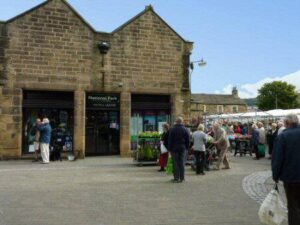
PEAK DISTRICT NATIONAL PARK
In 1951, the Peak was the first National Park set up in England and Wales. Bakewell, the only sizeable market town in the park, was the logical choice for the administrative centre. From its offices at Aldern House, it controls an area of 542 square miles. It covers parts of Staffordshire, Cheshire, West and South Yorkshire, Greater Manchester, and Derbyshire. When the park was set up, the resident population was only 38,000, which has not changed drastically since that day. Visitors flock to Bakewell in the summer to shop and explore its many nooks and crannies, admire its fine buildings, or relax and feed the ducks by the River Wye’s lovely, clear, sparkling waters. There is more space in the winter, but on a sunny day, that is limited.
AGRICULTURAL CONNECTION
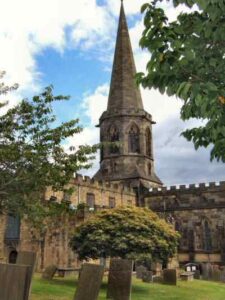
Bakewell is particularly busy every Monday, market day, when the stalls and the livestock market do brisk business. Until recently, the livestock market occupied a position near the centre of the town before moving to its new building on the other side of the river, away from the town centre. The strong connection with agriculture was further emphasised every August when the town held one of the oldest agricultural shows in the UK, which has almost 200 years of history. However, the 2017 and 2018 events were not held due to bad weather. The show was reduced to one day in 2019, and COVID-19 prevented it from taking place in 2020. It was not held again in 2021, and in 2022, the Bakewell Agricultural and Horticultural Society ran a new one-day event, the Bakewell Country Festival, in July instead of August, thus relegating the Bakewell Show to history.
BAKEWELL PUDDING
It was at the Rutland Arms. In about 1860, the hotel cook misunderstood her instructions and produced the world-famous Bakewell Pudding. Instead of stirring the egg mixture into the pastry, she spread it on top of the jam, which has to this day proved to be a stroke of genius in creating name awareness for the town.
In 1811, Jane Austen, who wrote Pride and Prejudice, is said to have stayed at the Rutland Arms and incorporated it into her writing. The hotel even named a suite after her to commemorate the visit.
ALL SAINTS’ CHURCH
The site on which All Saints’ Church stands has been used for worship since Anglo-Saxon times. It contains the most extensive and varied medieval monuments in the United Kingdom. The church has many references to the Manners and Vernon families. The story of the elopement of John Manners and Dorothy Vernon is one of the Peak District’s most romantic tales.
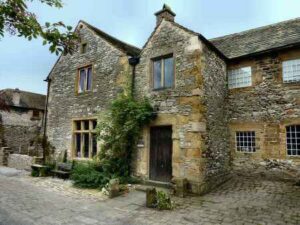
OLDE HOUSE MUSEUM
The Olde House Museum, hidden behind the church, is well worth seeking out. Originally a Parsonage, it was later converted into six cottages by Sir Richard Arkwright. Four more cottages were accommodated in the adjacent barn to house his workers at Lumford Mill.
It is now one of the best-preserved 15th-century houses in the country. But over 50 years ago, the local council nearly demolished it, having served a ‘Demolition Order’. There was an outcry locally, and the Bakewell Historical Society eventually saved and restored the house to its former glory. It is now a fascinating folk museum worth climbing up the hill to visit.
HOLME BRIDGE
Holme Bridge, dating from 1664, is on the western side of the town and was a former packhorse crossing point. Packhorse leaders from the Monyash direction used the bridge to avoid paying tolls in the centre of the town. Loads of up to two hundredweight were carried in pannier baskets slung on either side of the horse. The bridge was of sufficient width, and the parapets were low enough to enable a horse to cross to the other side.
The five-arched bridge across the River Wye is one of the best-known landmarks in the Peak. It dates from 1200, is among the oldest in the country, and is now designated as an Ancient Monument. From here, you have the choice of two short river walks. The first is to go upstream through the meadowland known as Scots Garden, passing Holme Hall, a small Jacobean Manor built in 1626, crossing the packhorse bridge, and returning along the A6 to Bakewell. The second is to walk along the side of the river to the sports ground and back.
BATH GARDENS
Across from Rutland Square, at the far end of Bath Gardens, is the Bath House. The Duke of Rutland, who owned the premises, tried establishing Bakewell as a spa town, similar to Buxton and Matlock. However, the warm water from the natural spring, at only 15 degrees centigrade, was too cold.

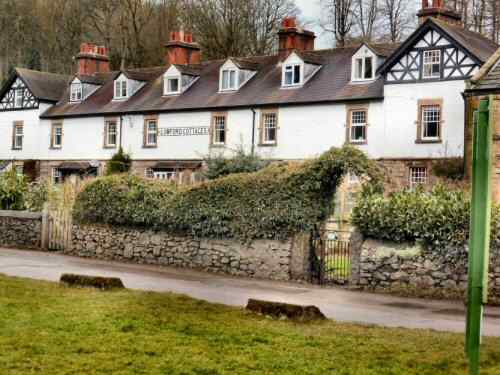
TEN FASCINATING FACTS ABOUT BAKEWELL

1. Peak Park marked its 50th anniversary in 2001, which must have been the worst year in its history due to the foot-and-mouth epidemic.
2. Less than 200 years ago, Bakewell presented a completely different picture with narrow streets and timber-framed properties, many of which had thatched roofs.
3. The modern layout of the town only came about in the 19th century. Rutland Square was created, and the Rutland Arms replaced the Old White Horse Inn.
4. Halfway down Bagshaw Hill is Bagshaw Hall, the former home of Thomas Bagshaw, a solicitor. The house is a pleasing mixture of gritstone and limestone; the town is on the edge of both areas.
5. Arkwright’s cotton-spinning factory at Lumford Mill, built about 1782 at its Peak, employed about 350 people, mainly women and children. It was sold to the Duke of Devonshire in 1860, but unfortunately, it was burnt down eight years later. After rebuilding, it operated as a cotton factory until the end of the century.

6. Victoria Mill stands on the outskirts of Bakewell, where an old Saxon Corn Mill once stood. The mill was used for grinding corn until 1945. The water wheel, now looking rather forlorn in the yard, is 25 feet in diameter.
7. The Old Market Hall was built as an open-sided market hall. Since then, it has served many purposes: as a washhouse, dance hall, library, and restaurant. Now, it acts as a Peak District Information Centre.
8. Arkwright Square on Buxton Road dates from the late 18th century when cottages were built for the workers at Sir Richard Arkwright’s Cotton Spinning Mill at Lumsdale.
9. The modern Agricultural Business Centre holds conferences and events annually. Monday is a livestock market day; a farmers’ market is generally held on the last Saturday of the month.
10. The well-dressing week concludes with the carnival, when a procession of floats and bands parade through the town, which ends with a fete in the recreation ground. For more information, visit www.bakewellcarnival.co.uk
Edensor and Chatsworth Park Walk
